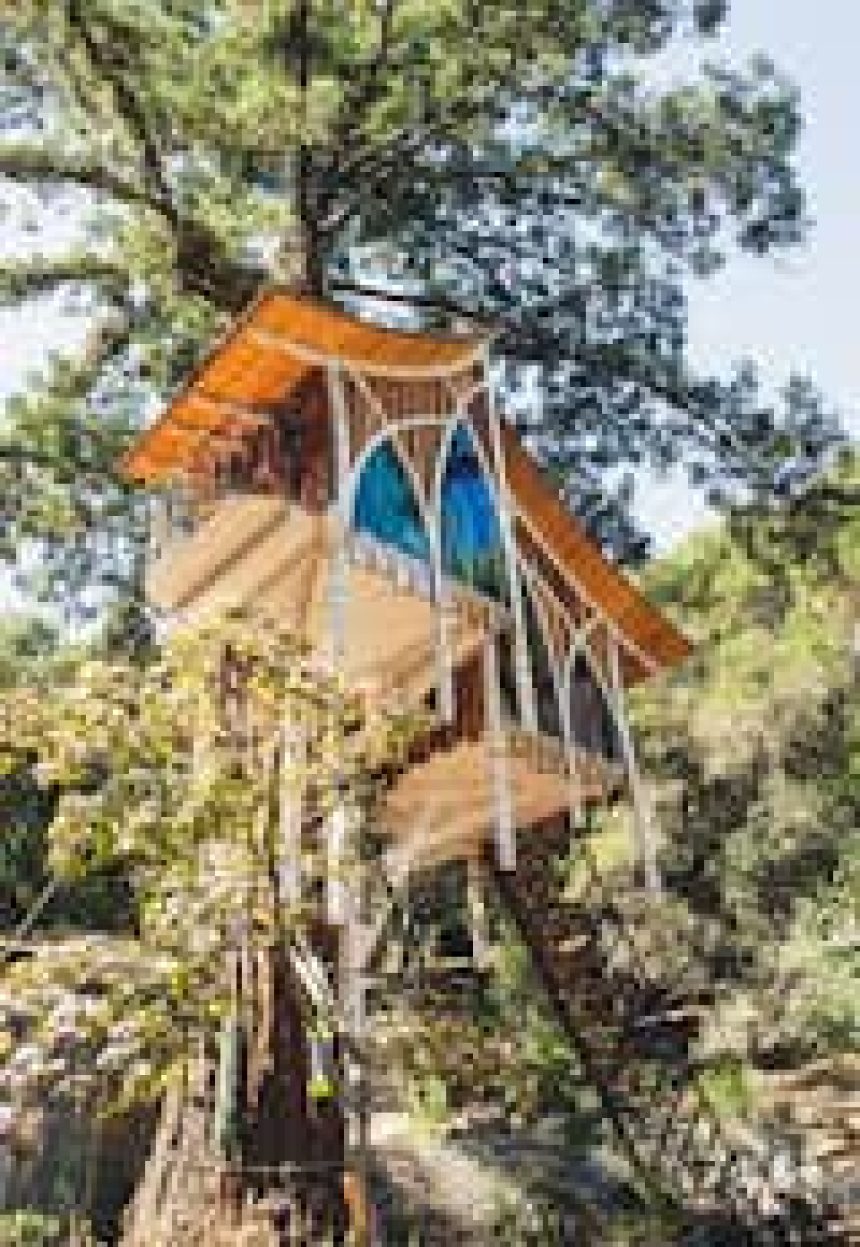Welcome to Tiny Home Profiles, an interview series with people pushing the limits of living small. From space-saving hacks to flexible floor plans, here’s what they say makes for the best tiny homes on the planet. Know of a builder we should talk to? Reach out.
There are tree houses and then there are ones by O2 Treehouse. Founded by Dustin Feider in 2006, the Oakland company merges his love of design and nature in a way that radically departs from any of the 2×4 forts you might have grown up with. The company’s portfolio includes a geodesic pine cone, a suspended climbing pod built using woven nets, and a faceted sphere structure with a tree growing through its center, crafted for The Doors guitarist Robby Krieger.
The company recently worked with a family in Northern California to complete its newest design: a fantastical elven-inspired tree house appropriately dubbed Rivendllë, a reference to J.R.R Tolkien’s mythical valley in The Hobbit and Lord of the Rings. The 101-square-foot build features curved rafters, redwood siding, and a cedar-shingled roof that coalesce as a storybook-inspired backyard hideout.
Here, Feider delves into how the company dreams up their projects—and what it takes to pull them off.
What qualities make your tiny homes stand apart from the rest?
O2 Treehouse creates one-of-a-kind structures that connect people to the natural world and facilitate wonder for all ages. We pride ourselves on a collaborative process where we take a client’s budget and functional and aesthetic desires and find something that fits their aims. We like creating complicated forms that are still within code.
What’s the most exciting project you’ve realized to date?
The Pinecone was a landmark, but it’s since been surpassed by the Cloud Ripple project. The clients came to me with an old tree house they wanted to remove. They had previously hosted a dinner on construction scaffolding, which they loved so much they decided to build a tree house they could use as a dining deck. After exploring the site, we saw the capacity for something grander and integrated a kids’ play structure. The result was a primary structure with an almost boat-like form, encompassed by a wrapping facade that creates an understory play area.
The Cloud Ripple structure includes multi-story netting with a flowing organic shape that extends from the underside of the ship-like central deck, featuring offset oculi that allows kids to climb between levels and access the different tree houses. We designed the netting with a gradient color palette of blues and purples that resemble the fruiting body of basket fungi.
The project’s size allowed us to create a whole series of interconnected structures with rope bridges. I made a geodesic structure with all glass instead of plexiglass. It developed a mushroom-growth theme that evolved throughout the design, which resulted in a flowing and bubbly shape that encompasses four redwood trees. It features a spiral staircase for access, and the railing fall protection mimics turkey tail mushrooms that naturally grow off redwood trees.
What does your base model cost and what does that pricing include?
The base model cost for custom work is $50,000, which will achieve either a cool kids’ play structure with an interior space and kinetic features, or on the short-term rental side, a simple geometric structure with a space of around 100 square feet. We also have standard models in our geodesic line of suspended shapes that start at $25,000 to $100,000 fully installed.
Installation is included in our costs, though this can be tricky for tree houses. We estimate average installation costs based on site conditions, ideally requiring vehicle access within 50 to 100 feet. Sometimes we need to zipline materials into the site to access different parts of the forest. Installation methods vary depending on the structure, design, and trees. We either suspend the tree houses behind trees, use beam or truss systems to span between trees, or work within a single tree structure.
What aspects of the design can a client customize?
Everything is customizable within a custom path, and even with our standard models, many elements can be changed, including flooring, canvas color, window location, and tree height to an extent. If there aren’t trees large enough, we can also stilt a structure. Because we have a custom fabrication facility, we can accommodate custom add-ons including lofts, rope bridges, and other additions.
Where are your tiny homes currently available?
We work nationwide and to a lesser extent internationally. Because we’re used to shipping prefabricated elements and mobilizing our specialized crews, and because the structures are highly custom, we are able to work overseas as well.
How long can a client expect the process to take after they put down a deposit?
For the custom process, our average is two to four months in design, two to four months in prefab, and two to four months in installation.
For one of our standard models there is a minimal window of design time, and prefab and installation may happen within a shorter window, but it varies depending on the model, the client’s customization, and the logistics and location of the site.
Do you assist with the placement of the tree house?
We are available to be hired to run permitting. In almost all cases, because of the specialty installation required, we come out and work with the client to find the best location for installation on the property. Our service includes everything from permitting to site prep to ensuring everything from the electrical to plumbing systems is working.
More Tiny Home Profiles:














